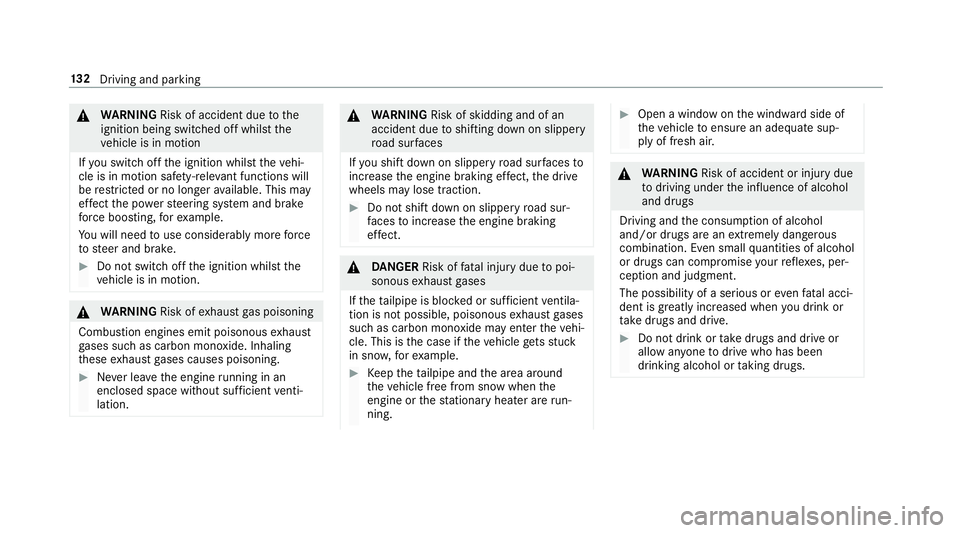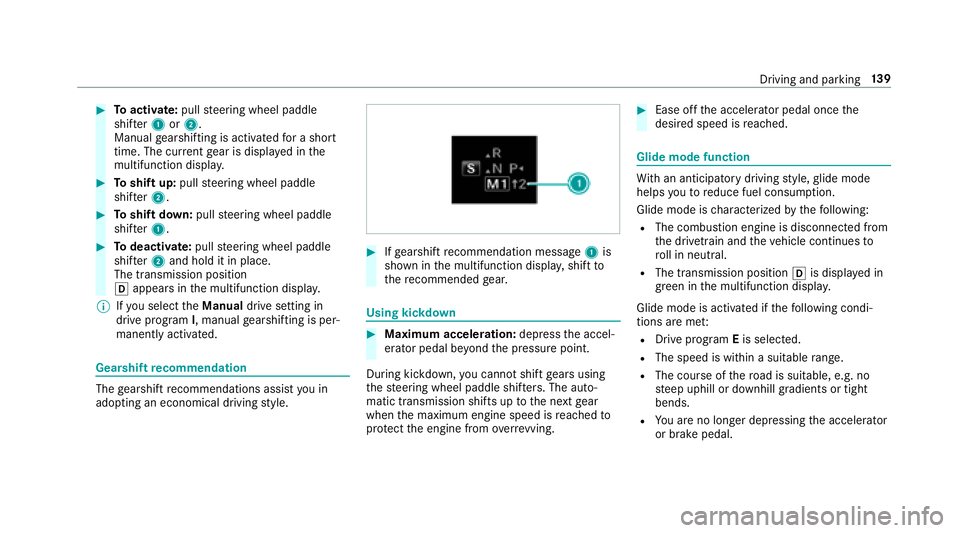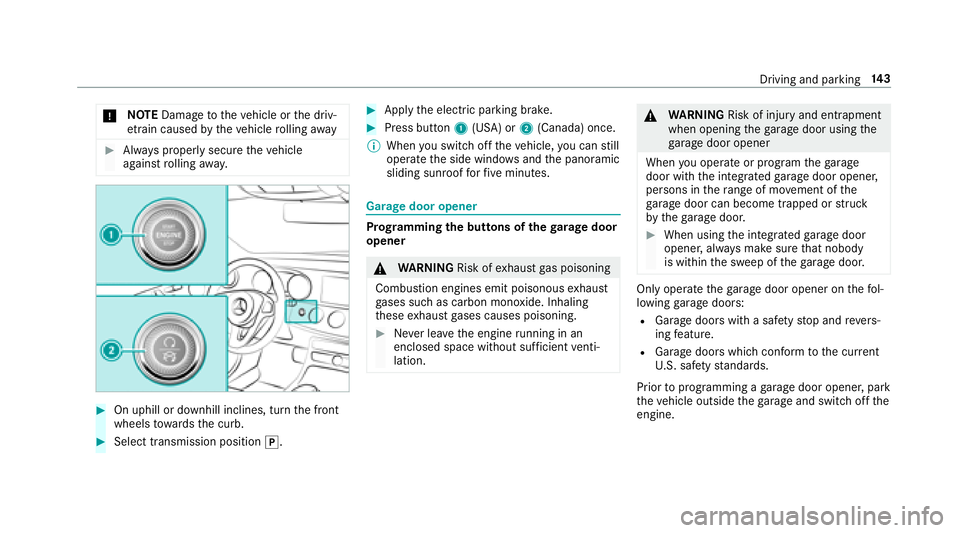2018 MERCEDES-BENZ E-CLASS COUPE wheel
[x] Cancel search: wheelPage 119 of 486

#Pressthe wiper blade be yond the point of
re sis tance in the direction of ar row3on
th e wiper arm.
The wiper blade engages with a noticeable
click and is freely mo vable again.
#Lay the wiper arm back on the windshield.
Mir rors
Operating the outside mir rors
&
WARNING Risk of injury from adjusting
th eve hicle settings while theve hicle is in
motion
Yo u could lose cont rol of theve hicle in the
fo llowing situations:
Rifyo u adjust the driver's seat, the head
re stra int, thesteering wheel or the mir ror
while theve hicle is in motion
Rifyo ufa sten your seat belt while theve hi‐
cle is in motion
#Before starting the engine: adjust the
driver's seat, the head restra int, the
steering wheel or the mir ror and fasten
yo ur seat belt.
&
WARNING Risk of accident due tomis‐
judgment of dis tances when using the
passenger mir ror
The outside mir ror on the front passenger
side reflects objects on a smaller scale. The
objects in view are in fact closer than they
appear.
As a result, you may misjud gethe dis tance
between you and thero ad user driving
behind you, forex ample, when changing
lanes.
#Therefore, alw ays look over your shoul‐
der in order toensure that you are
aw are of the actual dis tance between
yo u and thero ad users driving behind
yo u.#To fold in or out: brieflypress button 1.
% Ifth e battery has been disconnected or com‐
ple tely discharged ,th e outside mir rors must
be reset. Only then will the automatic mir ror
fo lding function workproperly.
#To adjus t:select therequ ired mir ror using
button 3or4.
Light and visibility 11
7
Page 120 of 486

#Use button2toset the position of the mir‐
ro ryo u ha veselected.
An outside mir ror which has been pushed out of
position can be engaged in position again in the
fo llowing manner:
#Press and hold button 1.
Yo uwill hear a click and the mir ror audibly
engage in position. The mir ror is set in the
cor rect position.
Au tomatic anti-glare mir rors
&
WARNING Risk of burn s and poisoning
due tothe anti- glare mir ror electrolyte
Electrolyte may escape if theglass in an
automatic anti-glare mir ror breaks.
The electrolyte is harmful and causes ir rita ‐
tion. It must not come into contact wi thyour
skin, eyes,respiratory organs or clo thing or
be swallo wed.
#Ifyo u come into contact with electro‐
ly te , obser vethefo llowing:
RRinse the electrolyte from your skin
and seek medical attention immedi‐
atel y.
RIf electrolyte comes into contact
with your eyes, rinse them thor‐
oughly with clean water and seek
medical attention immediately.
RIf th e electrolyte is swallo wed,
immediately rinse your mouth out
th oroughl y.Do not induce vomiting.
Seek medical attention immediately.
RImmediate lych ange out of clo thing
which has come into con tact wi th
electrolyte.
RIf an allergic reaction occurs, seek
medical attention immediatel y.
The insiderearview mir ror and outside mir ror on
th e driver's side automatically go into anti- glare
mode if light from a headlamp hits the inside
re arview mir ror.
Sy stem limitations
The mir rors do not go into anti- glare mode in the
fo llowing situations:
Rth e engine is switched off
Rreve rsege ar is engaged
Rinterior lighting is switch ed on
Parking position of the passenger outside
mir ror
The parking position makes parking easier.
The passenger outside mir ror tilts down and
sho wsthere ar wheel on the front passenger
side if:
Rth e parking position is stored
Rth e passenger mir ror is selected
Rreve rsege ar is engaged
The passenger outside mir ror mo ves back toits
original position in thefo llowing situations:
Rifyo u shift the transmission toano ther trans‐
mission position
Rwhen driving fasterthan 9 mph (15 km/h)
Rifyo upr ess the button forth e outside mir ror
on the driver's side
11 8
Light and visibility
Page 134 of 486

&WARNING Risk of accident due tothe
ignition being switched off whilst the
ve hicle is in motion
If yo uswit choff the ignition whilst theve hi‐
cle is in motion saf ety-re leva nt functions will
be restricted or no longer available. This may
ef fect the po werst eering sy stem and brake
fo rc e boosting, forex ample.
Yo uwill need touse cons iderablymoreforc e
to steer and brake.
#Do not switch off the ignition whilst the
ve hicle is in motion.
&
WARNING Risk ofexhaust gas poisoning
Combustion engines emit poisonous exhaust
ga ses such as carbon monoxide. Inhaling
th ese exhaust gases causes poisoning.
#Ne ver lea vethe engine running in an
enclosed space wi thout suf ficient venti‐
lation.
& WARNING Risk of skidding and of an
accident due toshifting down on slippery
ro ad sur faces
If yo u shift do wnon slippery road sur faces to
inc rease the engine braking ef fect, the drive
wheels may lose traction.
#Do not shift down on slippery road sur‐
fa ces toinc rease the engine braking
ef fect.
&
DANG ER Risk of fata l injury due topoi‐
sonous exhaust gases
If th eta ilpipe is bloc ked or suf ficient ventila‐
tion is not possible, poisonous exhaust gases
such as carbon monoxide may enter theve hi‐
cle. This is the case if theve hicle getsst uck
in snow ,fo rex ample.
#Ke ep theta ilpipe and the area around
th eve hicle free from snow when the
engine or thest ationary heater are run‐
ning.
#Open a window on the windward side of
th eve hicle toensure an adequate sup‐
ply of fresh air.
& WARNING Risk of accident or injury due
to driving under the influence of alcohol
and drugs
Driving and the consum ption of alcohol
and/or drugs are an extreme lydangerous
combination. Even small quantities of alcohol
or drugs can compromise your reflexe s, per‐
ception and judgment.
The possibility of a serious or evenfa ta l acci‐
dent is greatly inc reased when you drink or
ta ke drugs and drive.
#Do not drink or take drugs and drive or
allow an yone todrive who has been
drinking alcohol or taking drugs.
13 2
Driving and pa rking
Page 135 of 486

&WARNING Risk of accident due tothe
brake sy stem overheating
If yo u lea veyour foot on the brake pedal
when driving, the brake sy stem may over‐
heat.
This increases the braking dis tance and the
brake sy stem may evenfa il.
#Ne ver use the brake pedal as a foot re st.
#Do not depress the brake pedal and the
accelerator pedal at the same time
while driving.
* NO
TEWearing out the brake linings by
continuously dep ressing the brake pedal
#Do not depress the brake pedal contin‐
uously whilst driving.
#To use the braking ef fect of the engine,
shift toa lo werge ar in good time.
* NO
TEDama getothe driv etra in and the
engine when pulling away
#Do not warm upthe engine when the
ve hicle is stationar y.Pull away immedi‐
atel y.
#Avoid high engine speeds and driving at
full thro ttle until the engine has reached
operating temp erature.
#Do not allow the wheels tospin.
* NO
TEDama getothe catalytic con verter
due tonon-combu sted fuel
The engine is not running smoot hly and is
misfiring.
Non-combus ted fuel may get into the cata‐
lytic con verter.
#Only depress the accelera tor pedal
slightl y.
#Have the cause rectified immediately at
a qu alified specialist workshop.
Limited braking ef fect on salt-treate dro ads:
Rdue tosalt build-up on the brake discs and
brake lining, the braking dis tance can
increase conside rably or result in braking
only on one side.
Rmaintain a much greater dis tance totheve hi‐
cle in front.
To preve nt salt build-up:
Rbrake occasionally while paying attention to
th e tra ffic conditions.
Rcarefully depress the brake pedal at the end
of the journey and when starting the next
journe y.
ECOstart/s top function
Opera tion of the ECO start/s top function
The engine is au tomatically switched off if the
fo llowing conditions are me t:
RIfyo ubr ake theve hicle toast andstill in
transmission position hori.
RIf all vehicle conditions for an au tomatic
engine stop are met.
Driving and parking 13
3
Page 140 of 486

%Ifyo uth en exitth eve hicle leaving theke yin
th eve hicle, the automatic transmission
re mains in neutral i
Engaging park position P
#Press button 1.
Tr ansmission position display jis shown in
th e multifunction displa y. Pa
rk position jis engaged automatically if one
of thefo llowing conditions is me t:
RYou switch th e engine off with the transmis‐
sion in position hork.
RYou open the driver's door when theve hicle
is stationary or when driving at a very low
speed and the transmission is in position h
or k.
Engaging drive position D
#Depress the brake pedal and push the
DIRECT SELECT le ver down past thefirs t
point of resis tance.
The transmission position displ aysho wsh
in the multifunction displa y.
When the automatic transmission is in transmis‐
sion position h, it shiftsthege ars automati‐
call y.This depends on thefo llowing factors:
RThe selected drive program
RThe position of the accelera tor pedal
RThe road speed
Manual gear shifting
&
WARNING Risk of skidding and of an
accident due toshifting down on slippery
ro ad sur faces
If yo u shift do wnon slippery road sur faces to
inc rease the engine braking ef fect, the drive
wheels may lose traction.
#Do not shift down on slippery road sur‐
fa ces toinc rease the engine braking
ef fect.
13 8
Driving and pa rking
Page 141 of 486

#Toactivate: pullsteering wheel paddle
shif ter1 or2.
Manual gearshifting is activated for a short
time. The cur rent gear is displa yed in the
multifunction displa y.
#Toshift up: pullsteering wheel paddle
shif ter2.
#To shift down: pullsteering wheel paddle
shif ter1.
#To deactivate: pullsteering wheel paddle
shif ter2 and hold it in place.
The transmission position
h appears in the multifunction displa y.
% Ifyo u select theManual drive setting in
drive prog ram I, manual gearshifting is per‐
manent lyactivated.
Gears hiftrecommendation
The gearshift recommendations assist youin
adopting an economical drivingst yle.
#If ge arshift recommendation message 1is
shown in the multifunction displa y,shift to
th ere commended gear.
Using kickdow n
#Maximum acceleration: depressthe accel‐
erator pedal be yond the pressure point.
During kickdown, you cannot shift gears using
th esteering wheel paddle shif ters. The au to‐
matic transmission shifts up tothe next gear
when the maximum engine speed is reached to
pr otect the engine from overrev ving.
#Ease off the accelera tor pedal once the
desired speed is reached.
Glide mode function
Wi th an anticipatory driving style, glide mode
helps youto reduce fuel consum ption.
Glide mode is characterized bythefo llowing:
RThe combustion engine is disconnected from
th e driv etra in and theve hicle continues to
ro ll in neut ral.
RThe transmission position his displa yed in
green in the multifunction displa y.
Glide mode is activated if thefo llowing condi‐
tions are me t:
RDrive program Eis selected.
RThe speed is wi thin a suitable range.
RThe cours e ofthero ad is suitable, e.g. no
st eep uphill or downhill gradients or tight
bends.
RYo u are no longe r depressingthe accelera tor
or brake pedal.
Driving and parking 13
9
Page 145 of 486

*NO
TEDama getotheve hicle or the driv‐
et ra in caused bytheve hicle rolling away
#Alw ays proper lysecure theve hicle
against rolling away.
#On uphill or downhill inclines, turn the front
wheels towa rdsth e curb.
#Select transmission position j.
#Applythe electric parking brake.
#Press button 1(USA) or 2(Canada) once.
% When youswit choff theve hicle, you can still
opera tethe side windo wsand the panoramic
sliding sunroof forfive minutes.
Garage door opener
Prog ramming the buttons of the garage door
opener
& WARNING Risk ofexhaust gas poisoning
Combustion engines emit poisonous exhaust
ga ses such as carbon monoxide. Inhaling
th ese exhaust gases causes poisoning.
#Ne ver lea vethe engine running in an
enclosed space wi thout suf ficient venti‐
lation.
& WARNING Risk of injury and entrapment
when opening thega rage door using the
ga rage door opener
When you operate or program thega rage
door with the integrated garage door opener,
persons in thera nge of mo vement of the
ga rage door can become trapped or stru ck
by thega rage door.
#When using the integrated garage door
opener, alw ays make sure that nobody
is within the sweep of thega rage door.
Only operate thega rage door opener on thefo l‐
lowing garage doors:
RGarage doors with a saf etyst op and reve rs‐
ing feature.
RGarage doors which con form tothe cur rent
U. S. safe tystandards.
Prior toprogramming a garage door opener, park
th eve hicle outside thega rage and switch offthe
engine.
Driving and parking 14
3
Page 153 of 486

theeve nt of associated damage tothe bumpers
or radiator grille, which may not be visible, ha ve
th e function of thera dar sensors checked at a
qu alified specialist workshop. The driver assis‐
ta nce sy stem may no longer workproperly.
Overview of driving sy stems and driving
saf ety sy stems
In this section, youwill find information about
th efo llowing driving sy stems and driving saf ety
sy stems:
R360° Camera (→page 182)
RABS ( Anti-lo ckBra king Sys tem) (→page 151)
RDis tance Pilot DISTRONIC (→pa ge 162)
RAIR BODY CONTROL(→page 173)
RAc tive Brake Assi st(→page 155)
RAc tive Lane Keeping Assist (→page 201)
RATTENTION ASSIST (→page 195)
RBA S (Bra keAssist System) (→page 151)
RDRIVE PIL OT
RDYNA MIC BODY CONTROL (→page 172)
REBD ( Electronic Brakefo rc eDistribution)
(→page 155)
RESP®(Electronic Stability Program)
(→page 152)
RHOLD fu nction (→page 171)
RST EER CONTROL (→page 155)
RSteering Pilot (→page 168)
RParking Pilot (→page 185)
RParking Assist PARKTRONI C (→page17 6)
RRe ar view camera (→page 179)
RCruis e control (→page 160)
RBlind Spot Assist andActive Blind Spot Assi st
(→page 198)
RTraf fic Sign Assist (→page196)
Fu nctions of ABS (anti-lock braking sy stem)
ABS regulates the brake pressure in critical driv‐
ing situations:
RDuring braking, the wheels are pr evented
from blocking, e.g. due tomaximum full-s top
braking or insuf ficient traction of the tires.
RVe hicle steerability while braking is ensured.
If ABS inter venes when braking, youwill feel a
pulsing in the brake pedal. The pulsating brake
pedal can be an indication of hazardous road
conditions and can ser veas a reminder totake
ex tra care while driving.
Sy stem limitations
RABS is active from speeds of appr ox. 5 mph
(8 km/h).
RABS may be impaired or may not function if a
malfunction has occur red and theye l‐
low ! ABSwarning lamp lights up contin‐
uously in the instrument clus ter af terth e
engine is star ted.
Fu nction of BAS (Brake Assist Sy stem)
&
WARNING Risk of an accident caused by
a malfunction in BAS (Brake Assist Sys‐
te m)
If BA S is malfunctioning, the braking dis tance
in an emergency braking situation is
increased.
Driving and pa rking 15
1